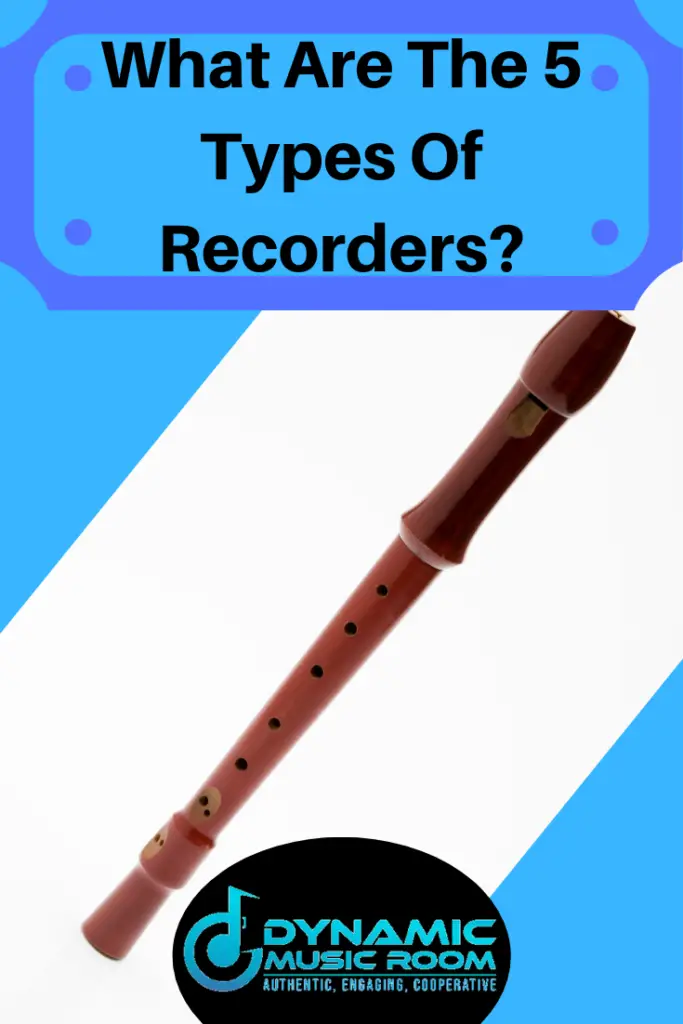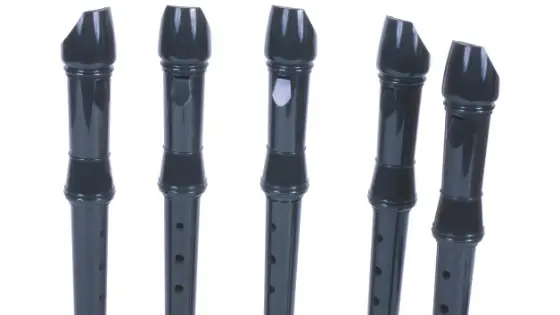One day I showed my students a video of someone playing a pop song on an alto recorder when one of my students asked me why it looked so different than his.
I was confused at first until I realized he was really asking: what are the 5 types of recorders?
The 5 main types of recorders used in recorder consorts (ensembles) are sopranino, soprano, alto, tenor, and bass. There are other specialty recorders as well.
Read on for more details about these types and other commonly asked questions about recorders.

Save time with these 60 FREE Music Resources to use in your room right away!
Stop searching the whole internet to find good activities. I’ll help you cut to the chase with my favorite 60 FREE resources.
Table of Contents
Types Of Recorders
In this section, we’ll dig into more details on the types of recorders there are. This section includes information on the recorders, their ranges, and where you may find them.
In this section, I also share some examples of these recorders you could buy. These links are affiliate in nature which means I earn a small commission if you buy it, but I only recommend products I’ve used and support.
Sopranino
The sopranino recorder is the smallest and highest of the 5 main types of recorders. This is the least common of the recorder types appearing in recorder consorts greater than 4 people.
Most standard recorder quartets consist of soprano, alto, tenor, and bass.
The sopranino recorder uses the lowest pitch F5. This gives it a functional range of F5-F6.
The sopranino isn’t often used in classrooms, but when part of a recorder consort (ensemble), the sopranino plays higher ornamental or counter-melody parts to the soprano’s melody.
A sopranino recorder is 7.87 inches long. The main challenges with playing this instrument are getting the higher pitches to sound full and maneuvering around the close finger holes.
The sopranino recorder by Aulos is a blast to play.
Soprano
The soprano recorder is the most common of all the recorder family. This instrument comes in around 11.81 inches long.
The size is perfect for the smaller fingers of 3rd-5th grade students.
The soprano recorder’s lowest pitch is C5. It has a functional range from C5-C7.
In recorder consorts, the soprano recorder is often given the melody. Traditionally, the soprano recorder would replace the voice or other melodic instrument back in the Renaissance period.
The Soprano recorder is similar to the tin whistle (famously featured on My Heart Will Go On).
Check out our guide for My Heart Will Go On recorder.
The Yamaha 23Y is a good example of a soprano recorder you may want to purchase. I like this because it has a great balance of durability, sound quality, and price.
Check out my massive list of easy songs for the recorder!
Alto
The alto recorder is largest and lower than the soprano, but higher than the tenor. In shape and design, it looks exactly like the soprano recorder, only longer. The alto is 17.71 inches usually.
Modern day alto recorders have the lowest pitch of F4. This gives it a functional range of F4-F6.
These recorders can be read at written pitch but are also often read an octave below.
Back in the day (300 years ago), alto recorders were also commonly seen based on the pitch, G. This evolved to the standard F later on.
The alto recorder is sometimes given melody in recorder consorts if the group is a quartet of soprano, alto, tenor, and bass.
Alto recorders are also seen occasionally in elementary music programs with older students. They’re usually only found in programs where students play and learn a lot of recorder in order to introduce some harmonic elements.
Personally, I use the Aulos alto recorder to help my kids sing. As a male music teacher, I use the alto recorder to help them find their starting pitches without needing to go into falsetto too much.
This prevents kids’ singing in their “squeaky voice.”
Tenor
The tenor recorder is the next one lower from the alto recorder. Like the soprano recorder, (how loud is a soprano recorder?) tenor recorder is also based on C; this recorder is based on C4 to be exact.
This gives the tenor recorder a functional range of C4-C6. It is exactly one octave lower than the soprano and can be played with the exact same fingerings.
The tenor recorder typically adds a key to help reach the lowest holes which are beyond the reach of most fingers. Tenor recorders come in around 25.6 inches in length.
The tenor recorder isn’t often seen in elementary music rooms other than if the teacher uses it to help play along with students’ singing.
The Aulos tenor recorder is one I played on a lot in undergrad when I played in pick-up recorder consorts with other music-teachers-in-training. It’s fun to play (and on this year’s Christmas list for me!).
Bass
The bass recorder is the lowest of the standard 5 types of recorders. This recorder is based on F3 and plays one octave lower than the alto recorder.
This gives the bass recorder a functional range of F3-F5. The bass recorder is around 35 inches long.
This recorder uses a few keys to help your fingers reach all the holes. Some bass recorders have a bend in the neck to help you play the instrument in a comfortable position.
Bass recorders are common in recorder consorts although not often seen in elementary music programs.
As a tuba player by trade, I love playing the bass recorder, and the Yamaha bass recorder is the one I choose if it’s available.
Other Recorder Types
There are other uncommon types of recorders out there in advanced recorder groups. These recorders are rarely seen and have very specific uses.
Here are the other specialized types of recorders and their starting pitch:
- Garklein/Piccolo – C6
- Great bass – C3
- Contrabass – F2
- Sub-great bass – C2
- Sub-contrabass – F1

5 Types Of Recorders – Direct Comparison
Here’s a simple chart to help you see a direct comparison of the 5 types of recorders.
| Feature | Sopranino | Soprano | Alto | Tenor | Bass |
|---|---|---|---|---|---|
| Range | F5-F7 | C5-C7 | F4-F6 | C4-C6 | F3-F5 |
| Length | 7.87 inches | 11.81 inches | 17.71 inches | 25.6 inches | 35 inches |
| Purpose In Ensemble | Counter melody, ornament | Melody | Harmony, occasional melody | Harmony | Bass lines |
| General Price Range | Medium-low | Low | Medium | Medium-high | High |
Wood Vs Plastic Recorders
Traditionally, recorders were made of wood. Wood recorders are still considered the professional level of recorders even today.
Plastic recorders came into popularity with the inclusion of their playing in popular music methods, especially that of Gunild Keetman, co-founder of Orff-schulwerk.
Here is a quick pros and cons comparison of wood vs plastic recorders.
| Pros | Cons | |
| Wood Recorders | Better sound quality Smoother tone Stays in tune | Higher cost |
| Plastic Recorders | Affordable Durable Sounds louder | Poorer tone quality overall Thinner sound |
Commonly Asked Questions
What Is The Biggest Recorder Called? – The biggest recorder is the sub-contrabass recorder. This recorder is over 6 feet long.
What Is The Smallest Recorder Called? – The smallest recorder is the garklein.
Are Descant And Soprano Recorders The Same? – No, they are two different names for the same recorder size.
Do Recorders Come In Different Keys? – Yes, modern day recorders are either based on C or F. Hundreds of years ago, they came in all different keys, but modern day ones are only found in these two.
Conclusion
I hope you enjoyed learning a bit about what the 5 different types of recorders are. The most common is the soprano recorder, but you may find all the other types in recorder consorts.
These instruments are fun to play and to teach.

Save time with these 60 FREE Music Resources to use in your room right away!
Stop searching the whole internet to find good activities. I’ll help you cut to the chase with my favorite 60 FREE resources.

